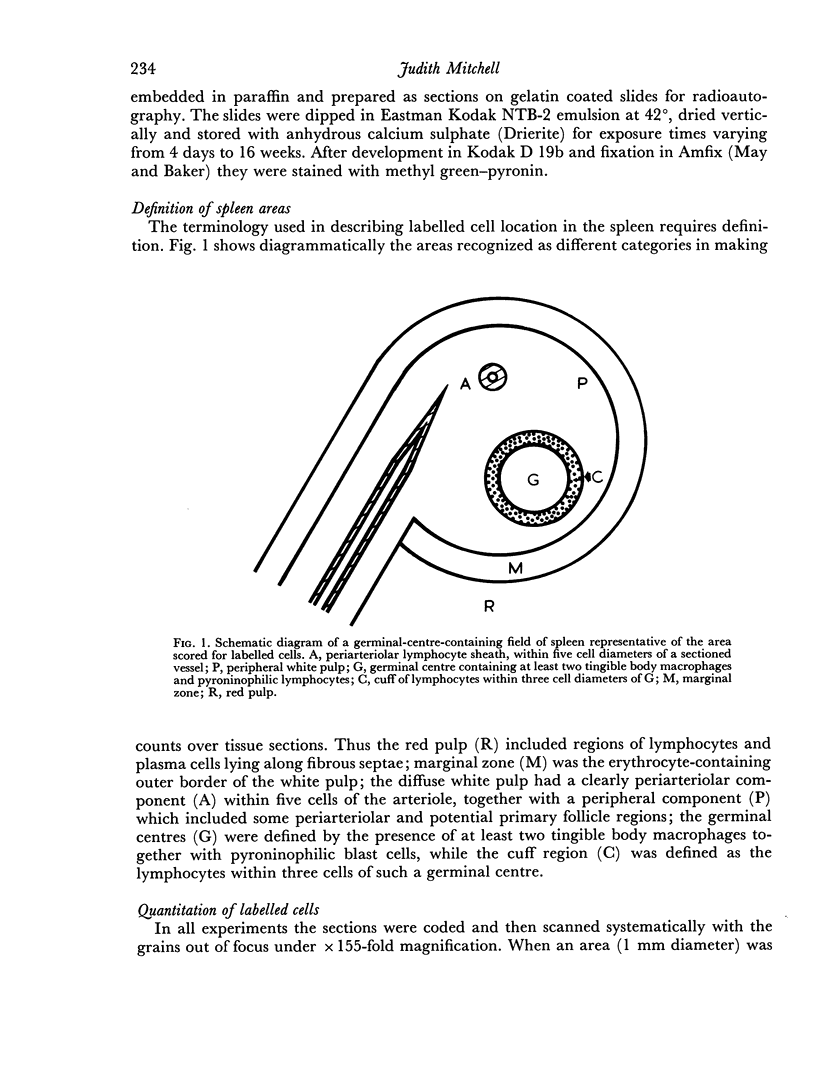Abstract
The purpose of this investigation was to compare and contrast the migratory behaviour of three sub-classes of spleen lymphocytes in the mouse: cells capable of adsorbing a specific labelled antigen on to their surfaces (`antigen-binding' cells); bone-marrow-derived (`B') cells; and thymus-derived (`T') cells.
Antigen-binding spleen cells were labelled in vitro with 125I-polymerized flagellin from Salmonella adelaide and injected intravenously into syngeneic recipients. Their distribution within the spleen was studied by radioautography for 24 hours after injection. Nearly all the antigen-binding cells localized and accumulated in and around the germinal centres of the white pulp.
Bone-marrow-derived B-spleen cells which were labelled in vitro with 3H-uridine were found to localize in and around germinal centres. The proportion of B cells found in these regions was lower than the proportion of antigen-binding cells and there was not a progressive aggregation of B cells over 48 hours.
Thymus-derived T-spleen cells also labelled in vitro with 3H-uridine were located predominantly in the established thymus-dependent periarteriolar regions of the white pulp.
The significance of the localization of antigen-binding cells in the germinal centre regions of spleen is discussed in relation to the B and T components of the spleen lymphocyte population. The conclusion was reached that B lymphocytes activated by contact with antigen lodged preferentially in germinal centre areas.
Full text
PDF














Images in this article
Selected References
These references are in PubMed. This may not be the complete list of references from this article.
- ADA G. L., NOSSAL G. J., PYE J., ABBOT A. ANTIGENS IN IMMUNITY. I. PREPARATION AND PROPERTIES OF FLAGELLAR ANTIGENS FROM SALMONELLA ADELAIDE. Aust J Exp Biol Med Sci. 1964 Jun;42:267–282. [PubMed] [Google Scholar]
- Ada G. L., Byrt P. Specific inactivation of antigen-reactive cells with 125I-labelled antigen. Nature. 1969 Jun 28;222(5200):1291–1292. doi: 10.1038/2221291a0. [DOI] [PubMed] [Google Scholar]
- Ada G. L., Humphrey J. H., Askonas B. A., McDevitt H. O., Nossal G. J. Correlation of grain counts with radioactivity (125I and tritium) in autoradiography. Exp Cell Res. 1966 Mar;41(3):557–572. doi: 10.1016/s0014-4827(66)80106-4. [DOI] [PubMed] [Google Scholar]
- Austin C. M. Patterns of migration of lymphoid cells. Aust J Exp Biol Med Sci. 1968 Oct;46(5):581–593. doi: 10.1038/icb.1968.165. [DOI] [PubMed] [Google Scholar]
- BLACK L., BERENBAUM M. C. FACTORS AFFECTING THE DYE EXCLUSION TEST FOR CELL VIABILITY. Exp Cell Res. 1964 Jun;35:9–13. doi: 10.1016/0014-4827(64)90066-7. [DOI] [PubMed] [Google Scholar]
- Brahim F., Osmond D. G. Migration of bone marrow lymphocytes demonstrated by selective bone marrow labeling with thymidine-H3. Anat Rec. 1970 Oct;168(2):139–159. doi: 10.1002/ar.1091680202. [DOI] [PubMed] [Google Scholar]
- Brown J. C., De Jesus D. G., Holborow E. J., Harris G. Lymphocyte-mediated transport of aggregated human gamma-globulin into germinal centre areas of normal mouse spleen. Nature. 1970 Oct 24;228(5269):367–369. doi: 10.1038/228367a0. [DOI] [PubMed] [Google Scholar]
- Byrt P., Ada G. L. An in vitro reaction between labelled flagellin or haemocyanin and lymphocyte-like cells from normal animals. Immunology. 1969 Oct;17(4):503–516. [PMC free article] [PubMed] [Google Scholar]
- Goldschneider I., McGregor D. D. Migration of lymphocytes and thymocytes in the rat. II. Circulation of lymphocytes and thymocytes from blood to lymph. Lab Invest. 1968 Apr;18(4):397–406. [PubMed] [Google Scholar]
- Greaves M. F. Biological effects of anti-immunoglobulins: evidence for immunoglobulin receptors on 'T' and 'B' lymphocytes. Transplant Rev. 1970;5:45–75. doi: 10.1111/j.1600-065x.1970.tb00356.x. [DOI] [PubMed] [Google Scholar]
- Hanna M. G., Jr, Szakal A. K. Localization of 125I-labeled antigen in germinal centers of mouse spleen: histologic and ultrastructural autoradiographic studies of the secondary immune reaction. J Immunol. 1968 Nov;101(5):949–962. [PubMed] [Google Scholar]
- Miller J. F., Basten A., Sprent J., Cheers C. Interaction between lymphocytes in immune responses. Cell Immunol. 1971 Oct;2(5):469–495. doi: 10.1016/0008-8749(71)90057-8. [DOI] [PubMed] [Google Scholar]
- Miller J. F., Mitchell G. F. Cell to cell interaction in the immune response. I. Hemolysin-forming cells in neonatally thymectomized mice reconstituted with thymus or thoracic duct lymphocytes. J Exp Med. 1968 Oct 1;128(4):801–820. doi: 10.1084/jem.128.4.801. [DOI] [PMC free article] [PubMed] [Google Scholar]
- Mitchell J., Abbot A. Antigens in immunity. XVI. A light and electron microscope study of antigen localization in the rat spleen. Immunology. 1971 Aug;21(2):207–224. [PMC free article] [PubMed] [Google Scholar]
- Nossal G. J., Abbot A., Mitchell J., Lummus Z. Antigens in immunity. XV. Ultrastructural features of antigen capture in primary and secondary lymphoid follicles. J Exp Med. 1968 Feb 1;127(2):277–290. doi: 10.1084/jem.127.2.277. [DOI] [PMC free article] [PubMed] [Google Scholar]
- Nossal G. J., Austin C. M., Pye J., Mitchell J. Antigens in immunity. XII. Antigen trapping in the spleen. Int Arch Allergy Appl Immunol. 1966;29(4):368–383. [PubMed] [Google Scholar]
- Parrott D. V., De Sousa M. A., East J. Thymus-dependent areas in the lymphoid organs of neonatally thymectomized mice. J Exp Med. 1966 Jan 1;123(1):191–204. doi: 10.1084/jem.123.1.191. [DOI] [PMC free article] [PubMed] [Google Scholar]
- Pettersen J. C., Borgen D. F., Graupner K. C. A morphological and histochemical study of the primary and secondary immune responses in the rat spleen. Am J Anat. 1967 Sep;121(2):305–317. doi: 10.1002/aja.1001210209. [DOI] [PubMed] [Google Scholar]
- Sulitzeanu D., Naor D. The affinity of radioiodinated BSA for lymphoid cells. II. Binding of 125I-BSA to lymphoid cells of normal mice. Int Arch Allergy Appl Immunol. 1969;35(6):564–578. doi: 10.1159/000230210. [DOI] [PubMed] [Google Scholar]




